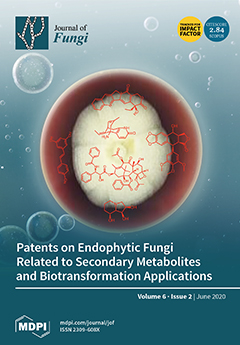It was hypothesized that white-rot fungus fermented with rice straw and purple field corn improves nutrient utilization via enhanced digestibility and lowers methane (CH
4) production due to the effects of the lovastatin compound. The aim of the current experiment was to investigate the effect of inoculation of two fungi belonging to white-rot fungus type on feed value and ruminal fermentation characteristic. The experiment was carried out according to a completely randomized 3 × 3 factorial design: three roughage sources (rice straw, purple corn stover, and purple corn field cob) for three inoculation methods (untreated,
P. ostreatus treated, and
V. volvacea treated). The two fungi increased concentration of lovastatin when compared to the untreated, and
P. ostreatus had higher lovastatin production potential than
V. volvacea (
p < 0.05). The yield of lovastatin was obtained from rice straw fermentation with
P. ostreatus. The monomeric anthocyanin content (MAC) in untreated purple field corn cobs was higher than in the fermentation groups. Ruminal fermentation gas production from soluble fractions ranged from −2.47 to 1.14 and differed among the treatments (
p < 0.01). In comparison to all treatments, the gas production rate for the insoluble fraction was significantly highest (
p < 0.01) in treatment alone, in which purple field corn stover was fermented with
P. ostreatus and
V. volvacea. There was significant interaction in in vitro dry matter digestibility at 12 h of incubation. Purple field corn cob had a higher significant effect on in vitro DM digestibility at 12 and 24 h after incubation when compared to that of other groups. Moreover, current research has found that roughage fermented with
P. ostreatus and
V. volvacea increased in vitro DM digestibility at 24 h after incubation. Fermenting roughage with fungi did not affect rumen pH, which ranged from 6.60 to 6.91 (
p > 0.05), while
P. ostreatus resulted in increased levels of ruminal ammonia-nitrogen concentrations. Propionic acid increased in all roughages fermented with
P. ostreatus or
V. volvacea after 8 h of ruminal fermentation testing. The two fungi fermented as substrate treatments had significantly lower (
p < 0.05) CH
4 production. Based on the improved rumen DM digestibility and reduced CH
4 production,
P. ostreatus and
V. volvacea could be utilized for enhancing feeding efficiency of roughage.
Full article






